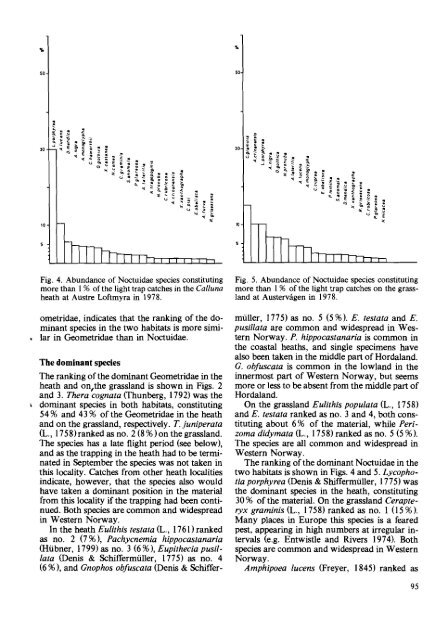o .eg an Jo of En1tomol0lD' - Norsk entomologisk forening
o .eg an Jo of En1tomol0lD' - Norsk entomologisk forening
o .eg an Jo of En1tomol0lD' - Norsk entomologisk forening
- No tags were found...
Create successful ePaper yourself
Turn your PDF publications into a flip-book with our unique Google optimized e-Paper software.
50<br />
50<br />
30<br />
10<br />
.<br />
.~<br />
"'<br />
Q.<br />
<br />
.<br />
,<br />
'"<br />
30<br />
10<br />
~<br />
.~<br />
"'<br />
I<br />
Fig. 4. Abund<strong>an</strong>ce <strong>of</strong> Noctuidae species constituting<br />
more th<strong>an</strong> I % <strong>of</strong> the light trap catches in the Cat/una<br />
heath at Austre L<strong>of</strong>tmyra in 1978.<br />
ometridae, indicates that the r<strong>an</strong>king <strong>of</strong> the domin<strong>an</strong>t<br />
species in the two habitats is more simi<br />
• lar in Geometridae th<strong>an</strong> in Noctuidae.<br />
The domin<strong>an</strong>t species<br />
The r<strong>an</strong>king <strong>of</strong> the domin<strong>an</strong>t Geometridae in the<br />
heath <strong>an</strong>d on,the grassl<strong>an</strong>d is shown in Figs. 2<br />
<strong>an</strong>d 3. Thera cognata (Thunberg, 1792) was the<br />
domin<strong>an</strong>t species in both habitats, constituting<br />
54% <strong>an</strong>d 43% <strong>of</strong> the Geometridae in the heath<br />
<strong>an</strong>d on the grassl<strong>an</strong>d, respectively. T. juniperata<br />
(L., I758) r<strong>an</strong>ked as no. 2 (8 %) on the grassl<strong>an</strong>d.<br />
The species has a late flight period (see below),<br />
<strong>an</strong>d as the trapping in the heath had to be terminated<br />
in September the species was not taken in<br />
this locality. Catches from other heath localities<br />
indicate, however, that the species also would<br />
have taken a domin<strong>an</strong>t position in the material<br />
from this locality if the trapping had been continued.<br />
Both species are common <strong>an</strong>d widespread<br />
in Western Norway.<br />
In the heath Eulithis testata (L., 1761) r<strong>an</strong>ked<br />
as no. 2 (7 %), Pachycnemia hippocast<strong>an</strong>aria<br />
(Hiibner, 1799) as no. 3 (6 %), Eupithecia pusillata<br />
(Denis & Schiffermiiller, 1775) as no. 4<br />
(6 %), <strong>an</strong>d Gnophos obfuscata (Denis & Schiffer<br />
Fig. 5. Abund<strong>an</strong>ce <strong>of</strong> Noctuidae species constituting<br />
more th<strong>an</strong> I % <strong>of</strong> the light trap catches on the grassl<strong>an</strong>d<br />
at Austervagen in 1978.<br />
muller, 1775) as no. 5 (5 %). E. testata <strong>an</strong>d E.<br />
pusillata are common <strong>an</strong>d widespread in Western<br />
Norway. P. hippocast<strong>an</strong>aria is common in<br />
the coastal heaths, <strong>an</strong>d single specimens have<br />
also been taken in the middle part <strong>of</strong> Hordal<strong>an</strong>d.<br />
G. obfuscata is common in the lowl<strong>an</strong>d in the<br />
innermost part <strong>of</strong> Western Norway, but seems<br />
more or less to be absent from the middle part <strong>of</strong><br />
Hordal<strong>an</strong>d.<br />
On the grassl<strong>an</strong>d Eulithis populata (L., 1758)<br />
<strong>an</strong>d E. testata r<strong>an</strong>ked as no. 3 <strong>an</strong>d 4, both constituting<br />
about 6% <strong>of</strong> the material, while Perizoma<br />
didymata (L., 1758) r<strong>an</strong>ked as no. 5 (5 %).<br />
The species are all common <strong>an</strong>d widespread in<br />
Western Norway.<br />
The r<strong>an</strong>king <strong>of</strong> the domin<strong>an</strong>t Noctuidae in the<br />
two habitats is shown in Figs. 4 <strong>an</strong>d 5. Lycophotia<br />
porphyrea (Denis & Shiffermiiller, 1775) was<br />
the domin<strong>an</strong>t species in the heath, constituting<br />
30 % <strong>of</strong> the material. On the grassl<strong>an</strong>d Cerapteryx<br />
graminis (L., 1758) r<strong>an</strong>ked as no. I (I5 %).<br />
M<strong>an</strong>y places in Europe this species is a feared<br />
pest, appearing in high numbers at irr<strong>eg</strong>ular intervals<br />
(e.g. Entwistle <strong>an</strong>d Rivers 1974). Both<br />
species are common <strong>an</strong>d widespread in Western<br />
Norway.<br />
Amphipoea lucens (Freyer, 1845) r<strong>an</strong>ked as<br />
95

















